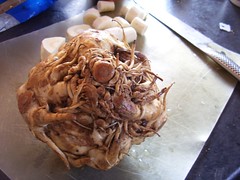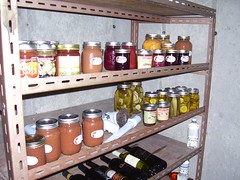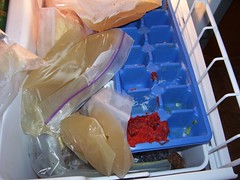I've been sharing recipes in my Eating Seasonally posts, but it occurred to me recently that more than recipes is required to eat local, seasonal foods--there are lots of tips and tricks that you need to make this a realistic way of life. So I thought today I'd share a few of the tricks I use to eat semi-seasonally in the winter. Some of these tips could be useful even if you're not trying to eat locally--the freezing tips are a great way to prevent waste of food, no matter where it's from. Some are quick and easy, others are more time consuming--they may not all be for everyone, but I hope there is something you can take away from this.
Eating local produce in the winter takes 2 forms for me. First, there are some local products still available--primarily root vegetables (potatoes, carrots, celeriac, beets, parsnips, etc.) and some varieties of squash, which are harvested in the fall and then stored through the winter. Some local farmers have greenhouses where they can produce a few things in the winter, but that can be pricey and the flavour is generally not the same as true summer produce.
I have a cold storage room, but have found it's a bit too damp in there to effectively store root veggies for months (I won't illustrate this for you--suffice it to say, there are some squash and onions that haven't fared well!). Luckily for me, there are many local farmers who DO have good storage, so I can buy from them through the winter. Many of the recipes I've posted in the last few months have relied on these veggies. Which reminds me, when I posted the Celeriac Soup recipe I promised that I would share a photo the next time I had celeriac here. So here you go:

Ugly sucker, isn't it? But it packs a lot of flavour! And yeah, those are parsnips in behind it.
OK, root veggies are great, but realistically eating this way all winter can get boring for even the most dedicated locavore. So if you want to taste summer year round, you have to preserve food. The idea of preserving my own food was originally really daunting to me, but I've learned that not all methods of preserving are labour intensive and challenging! Canning is what we all think of first, and it is a part of my preserving methods:

As you can probably see, my canning is mostly spreads (jam & apple butter), sauces (salsa & applesauce), and pickles. Plus a few jars of peaches (and some commerically canned products, too!). I may try a few more things next year, though--but canning can be a big job. If you're going to try canning, I recommend doing some reading first to figure out what you need to do it safely. The Bernardin Guide to Home Preserving is my favourite resource right now. It has recipes for lots of jams and sauces, overviews of the safety precautions you need to take, instructions for different methods of canning, and more.
Easier than canning, and something I plan to do a LOT of this year, is freezing. Freezing vegetables is WAY easier than canning them (most veggies don't have the acid content required to can them safely in a hot water bath). Freezing fruit is also great. Of course, freezing changes the produce, so it's important to keep in mind the end use of the produce so you can freeze it appropriately. Here are some tips:
The ice cube trick is something I use a lot--it's so easy to do, and so easy to use later in cooking. I also do this to prevent waste with other products, like tomato paste. You know how recipes almost always call for 1 Tablespoon, but the cans hold way more? Well, take the extra and freeze it in 1 T cubes for later use:

What is that beside the ice cube tray, you may ask? That's the other thing I wanted to talk about today, but we're running out of time so it will have to wait for a future post--all about homemade stocks and broths.
I know this was long, but hopefully the information about preserving different foods will help you plan a bit for next year. And if you have favourite methods of preservation that I didn't cover here, please share! Next week we'll talk more about making broth, and maybe some other tips and tricks to help you out.
Eating local produce in the winter takes 2 forms for me. First, there are some local products still available--primarily root vegetables (potatoes, carrots, celeriac, beets, parsnips, etc.) and some varieties of squash, which are harvested in the fall and then stored through the winter. Some local farmers have greenhouses where they can produce a few things in the winter, but that can be pricey and the flavour is generally not the same as true summer produce.
I have a cold storage room, but have found it's a bit too damp in there to effectively store root veggies for months (I won't illustrate this for you--suffice it to say, there are some squash and onions that haven't fared well!). Luckily for me, there are many local farmers who DO have good storage, so I can buy from them through the winter. Many of the recipes I've posted in the last few months have relied on these veggies. Which reminds me, when I posted the Celeriac Soup recipe I promised that I would share a photo the next time I had celeriac here. So here you go:

Ugly sucker, isn't it? But it packs a lot of flavour! And yeah, those are parsnips in behind it.
OK, root veggies are great, but realistically eating this way all winter can get boring for even the most dedicated locavore. So if you want to taste summer year round, you have to preserve food. The idea of preserving my own food was originally really daunting to me, but I've learned that not all methods of preserving are labour intensive and challenging! Canning is what we all think of first, and it is a part of my preserving methods:

As you can probably see, my canning is mostly spreads (jam & apple butter), sauces (salsa & applesauce), and pickles. Plus a few jars of peaches (and some commerically canned products, too!). I may try a few more things next year, though--but canning can be a big job. If you're going to try canning, I recommend doing some reading first to figure out what you need to do it safely. The Bernardin Guide to Home Preserving is my favourite resource right now. It has recipes for lots of jams and sauces, overviews of the safety precautions you need to take, instructions for different methods of canning, and more.
Easier than canning, and something I plan to do a LOT of this year, is freezing. Freezing vegetables is WAY easier than canning them (most veggies don't have the acid content required to can them safely in a hot water bath). Freezing fruit is also great. Of course, freezing changes the produce, so it's important to keep in mind the end use of the produce so you can freeze it appropriately. Here are some tips:
- When possible, spread loose fruits/veggies (peas, kernels of corn, chopped/slice pieces, etc.) on a cookie sheet and freeze that way. Once they are completely frozen, transfer to a freezer bag. This will help keep the individual bits from sticking together so you can use them later. It's not perfect, but it's way easier than trying to separate all those peach slices that have frozen into one big blob!
- Zucchini: it's a water-heavy vegetable, but I've found 2 methods that worked for freezing. First, I grated a bunch of zucchini and froze it. This is great if you want to make zucchini bread in the winter--just thaw it, strain off a bit of the liquid, and toss it in the batter! Secondly, last year I discovered 8 Ball Zucchini. I liked to slice them thickly and grill them, so I decided to freeze some slices. I've grilled them from frozen a few times (they do stick more to the grill from frozen, so use a grill pan & some oil), and also broiled some with great success!
- Fruit: frozen fruit is best used in baking (muffins, pies, cakes, cobblers, breads, etc.) or in smoothies. Or you can thaw it and eat with yogurt. It really doesn't work on your cereal the way fresh fruit does, though!
- Corn, peas, and green beans are really fabulous freezer veggies. In general, it is recommended to blanch veggies briefly before freezing for safety (the Bernardin book covers this, too!). They can both be quickly thrown into soups, stirred into casseroles, etc. or just cooked on their own. Last year I think I used up all my frozen local peas in October, so this year I'll be freezing huge quantities.
- Garlic: Fresh garlic has so much more flavour than garlic that's been stored (or shipped around the world. The grocery store garlic here is pretty much always from China, and it makes a difference!). To preserve this flavour for use later, I press (or mince) garlic when it's fresh, put it in ice cube trays (I have some trays where the cubes hold just 1-2 teaspoons--perfect size), and freeze it (sometimes I put a dash of oil in the cube). Pop the cubes out and into a freezer bag when you're done. Just toss the frozen cube into the pan when you would normally add garlic. It will take slightly longer to cook from frozen, but I think that's often a good thing--it's so easy to burn garlic in cooking, this slows that process down a bit!
- Herbs: I use the same basic method as with garlic here. Chop the herbs, put them in ice cube trays. But to hold the cubes together, you need to add a bit of liquid--broth or water work well, just a tiny bit. Throw the cubes into sauces and soups for some fresh flavour year round. You can also make pastes with herbs & other ingredients (garlic, oil, etc.) in a food processor and freeze those. Think about the flavour combinations you use a lot in cooking, and try to figure out how you can preserve those combos for use later!
The ice cube trick is something I use a lot--it's so easy to do, and so easy to use later in cooking. I also do this to prevent waste with other products, like tomato paste. You know how recipes almost always call for 1 Tablespoon, but the cans hold way more? Well, take the extra and freeze it in 1 T cubes for later use:

What is that beside the ice cube tray, you may ask? That's the other thing I wanted to talk about today, but we're running out of time so it will have to wait for a future post--all about homemade stocks and broths.
I know this was long, but hopefully the information about preserving different foods will help you plan a bit for next year. And if you have favourite methods of preservation that I didn't cover here, please share! Next week we'll talk more about making broth, and maybe some other tips and tricks to help you out.
Comments